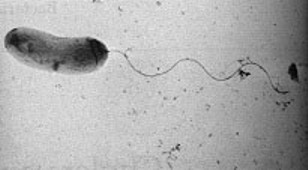Vibrio cholerae
A Microbial Biorealm page on the genus Vibrio cholerae
Classification
Higher order taxa
Bacteria; Proteobacteria; Gammaproteobacteria; Vibrionales; Vibrionaceae; Vibrio
Species
|
NCBI: Taxonomy |
Vibrio cholerae
Description and significance

Vibrio cholerae is "comma" shaped and has a single, polar flagellum for movement.There are numerous strains of V. cholerae, some of which are pathogenic and some of which are not. The most recent and wide sweeping pathogenic strain is the Vibrio cholerae serotype O1 or eltor N16961 strain. This is a pathogenic gram negative bacteria1 that causes the pandemic disease cholera.2 The bacteria infects the intestine and increases mucous production causing diarrhea and vomiting which result in extreme dehydration and, if not treated, death. It is usually transmitted through the feces of an infected person, often by way of unclean drinking water or contaminated food.2 Since water treatment and sanitation is more advanced in the United States, cholera is not nearly as high of a public health threat in the US as it is in densely populated, economically reduced areas like India or sub-Saharan Africa where water and sewage treatment technology is low.2
It is for this great risk to human health that makes it so worthy of studying and sequencing. And because of the variety of strains, it could be possible to determine the pathogenicity of new strains by comparing their genomes to strains of known pathogenic status.
Filippo Pacini first discovered V. cholereae in 1854, though for a long time it was believed to be Robert Koch, who did not actually discover it until 1882.
Describe how and where it was isolated. Include a picture or two (with sources) if you can find them.
Genome structure
The entire genome of the virulent strain V. cholerae El Tor N16961 has been sequenced,1 and contains two circular chromosomes.3 Chromosome 1 has 2,961,149 base pairs with 2,770 open reading frames (ORF’s) and chromosome 2 has 1,072,315 base pairs, 1,115 ORF’s. It is the larger first chromosome that contains the crucial genes for toxicity, regulation of toxicity and important cellular functions, such as transcription and translation.1
Other interesting features? What is known about its sequence? Does it have any plasmids? Are they important to the organism's lifestyle?
Cell structure and metabolism
Describe any interesting features and/or cell structures; how it gains energy; what important molecules it produces.
Ecology
Describe any interactions with other organisms (included eukaryotes), contributions to the environment, effect on environment, etc.
Pathology
How does this organism cause disease? Human, animal, plant hosts? Virulence factors, as well as patient symptoms.
Application to Biotechnology
Does this organism produce any useful compounds or enzymes? What are they and how are they used?
Current Research
Enter summaries of the most recent research here--at least three required
References
1. JF Heidelberg, JA Eisen, WC Nelson, et al. DNA sequence of both chromosomes of the cholera pathogen Vibrio cholerae, Nature 406 (6795), 477-483 (2000)
2. Center for Disease Control, Coordinating Center for Infectious Diseases / Division of Bacterial and Mycotic Diseases, October 6, 20005. http://www.cdc.gov/ncidod/dbmd/diseaseinfo/cholera_g.htm
3. M Trucksis, J Michalski, YK Deng, & JB Kaper. The Vibrio cholerae genome contains two unique circular chromosomes. Proc. Natl Acad. Sci. USA 95, 14464-14469 (1998).
Edited by Sasha Gardner, student of Rachel Larsen

